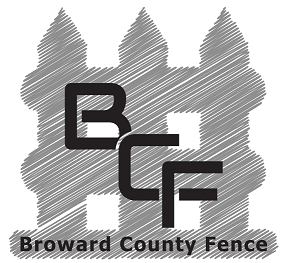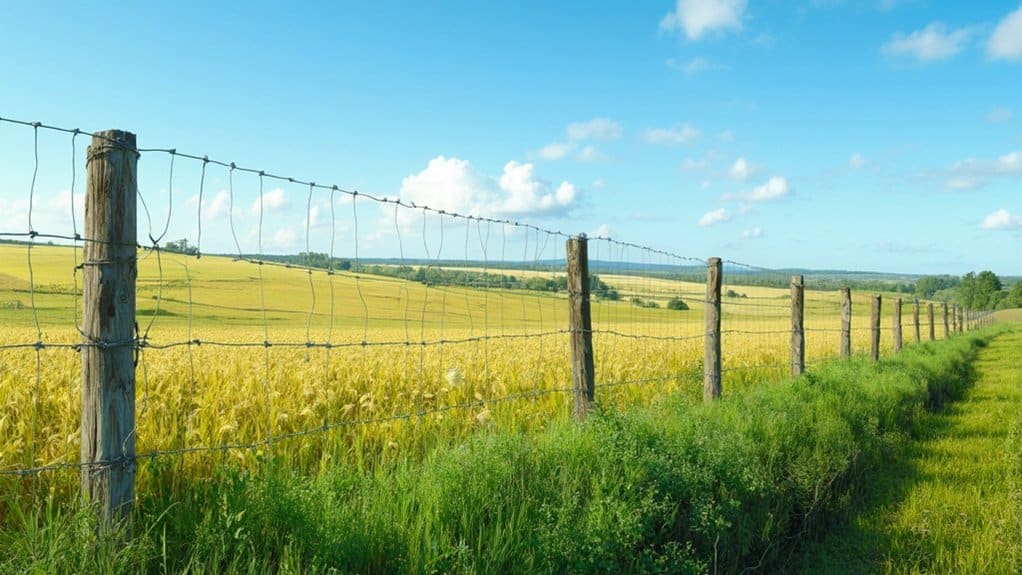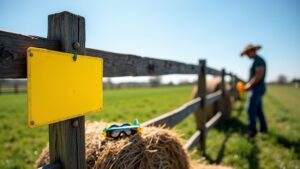When selecting farm fencing, prioritize your livestock and crop protection needs. For larger animals, high-tensile wire is effective, while woven wire suits smaller animals. Electric fencing is a flexible and budget-friendly option to keep wildlife away. To protect crops, combine mesh and electric fencing to deter pests like deer. Regular maintenance is crucial for extending your fence’s lifespan. Your fencing choices significantly influence your farm’s efficiency, so consider your options carefully.
Key Takeaways
- High-tensile wire is great for larger livestock because it’s strong and can last up to 50 years with proper care.
- Electric fencing is a budget-friendly and adjustable option for various animals, making it easy to customize based on your needs.
- Woven wire fencing is perfect for smaller animals, effectively keeping them safe and preventing escapes.
- Combination fencing, which mixes wire and electric options, offers solid protection for crops against wildlife threats.
- Sustainable materials like recycled HDPE and bamboo are eco-friendly alternatives that provide durability while lowering your carbon footprint.
Understanding Your Farm’s Fencing Needs
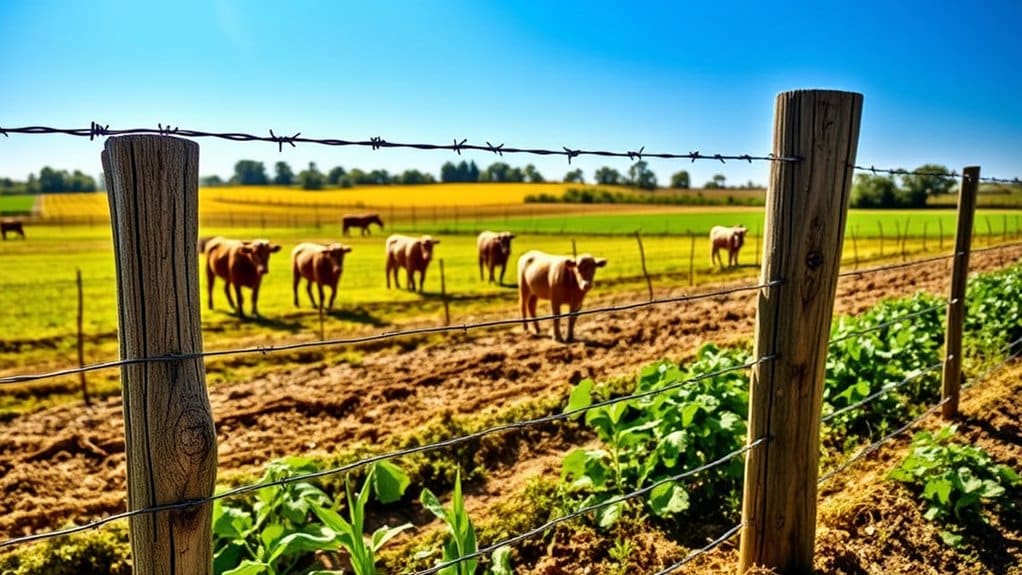
To determine your farm’s fencing needs, start by looking at a few key factors.
First, consider the size of your property; larger farms will need more fencing. Clearly mark your boundaries to estimate the materials and costs involved.
Think about areas that need protection, like crops or wildlife zones, as this will guide your fencing type. Additionally, consider the livestock containment requirements specific to the animals you will be raising, as this will affect the height and strength of your fencing.
Assess the land’s terrain too; uneven ground can affect installation and material choice.
Don’t forget to factor in existing structures like roads and gates to ensure your fence fits seamlessly into your farm operations.
Exploring Livestock Fencing Types
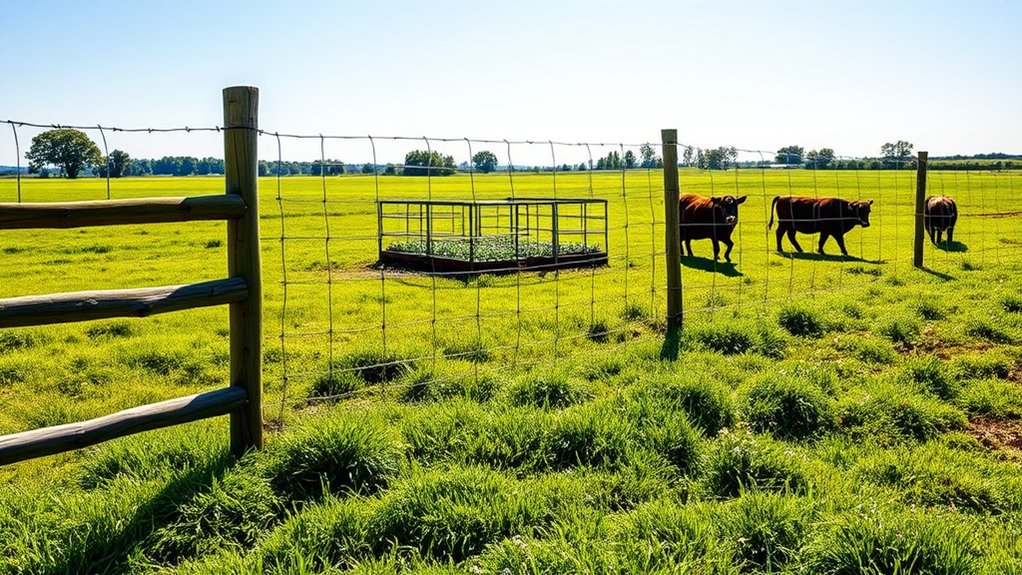
When choosing livestock fencing, it’s crucial to pick the right type based on the animals you have. For larger livestock like cattle, high-tensile wire is strong and reliable. High tensile fencing is a durable and cost-effective solution for livestock containment. Woven wire works well for smaller animals, such as sheep. If you need a temporary solution, electric fencing is an affordable option. Barbed wire can keep out intruders but can also harm your animals. Compare fencing materials by looking at durability, maintenance, and cost. Always follow safety standards to keep your livestock secure. Whether you prefer the look of post and rail fencing or the flexibility of portable options, selecting the right fence is key for effective livestock management.
Choosing the Right Fencing for Crop Protection
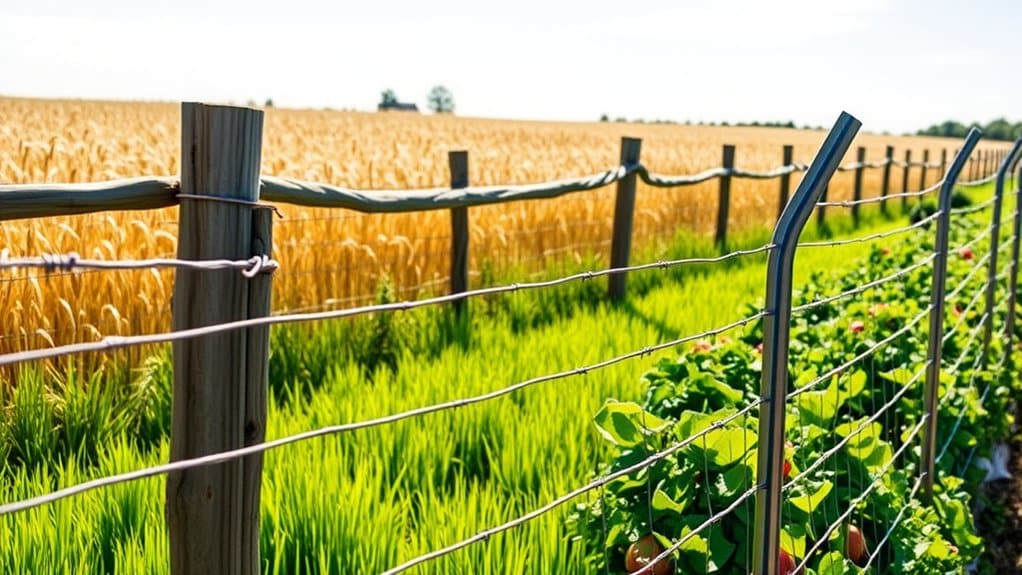
Choosing the right fencing is crucial for protecting your crops from pests and environmental threats. Here are some effective strategies:
- Wire Fencing: Great for keeping out small to medium-sized pests like rabbits and raccoons, especially for vegetables and grains. Understanding vulnerabilities aids in selecting appropriate fencing.
- Mesh Fencing: Low mesh fences work well to block rabbits and squirrels from getting into your vegetable gardens.
- Electric Fencing: Ideal for protecting high-value crops, electric fences deter larger animals, like deer, from invading your fields.
- Combination Fencing: A mix of wire and electric fencing offers comprehensive protection against a variety of threats.
Factors to Consider When Selecting Farm Fencing
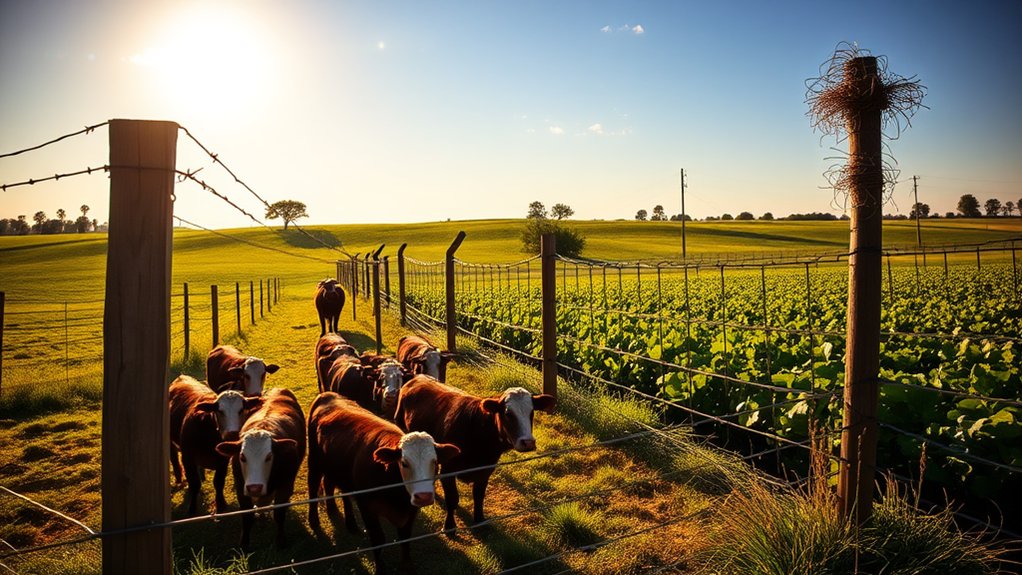
When choosing fencing for your farm, consider several key factors to ensure it meets your needs.
First, identify the fence’s purpose—whether for keeping livestock in, deterring predators, or protecting crops. For example, barbed wire is effective for cattle, while poultry require specialized mesh.
Next, assess your property’s size and layout to determine how much fencing you need. Using local materials can often save you money while providing durability.
Lastly, check local fencing regulations to ensure compliance. By balancing these elements, you can select the best fencing solution for your farm.
Maintenance Tips for Farm Fences
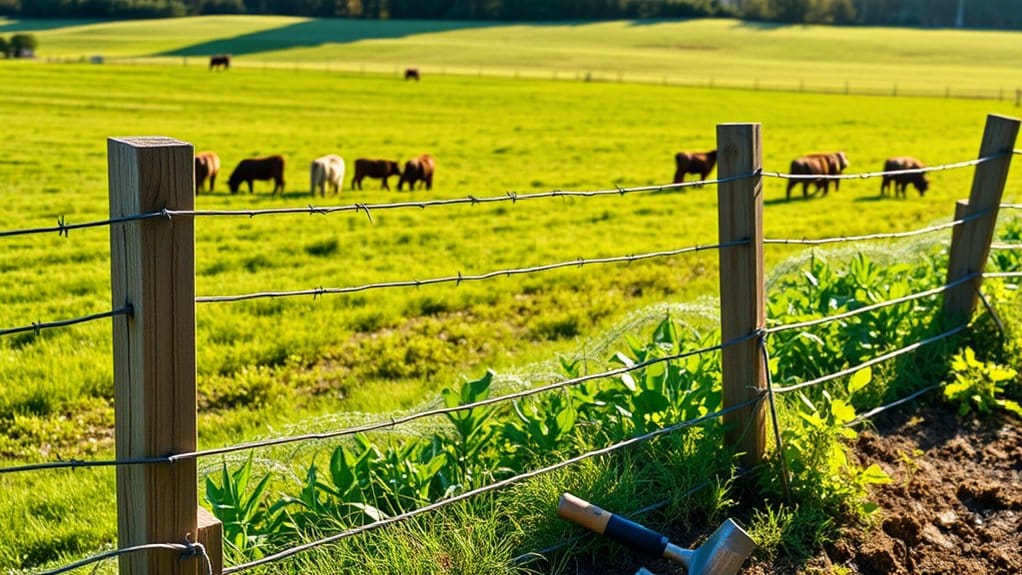
Maintaining your farm fences is crucial for their longevity and effectiveness.
Here are some straightforward tips to keep them in top shape:
- Inspect Regularly: Look for fallen branches, sagging wires, and leaning posts.
- Check for Damage: After rain, inspect wood for rot and metal for rust.
- Secure Posts: Ensure posts are stable to prevent any shifting.
- Adjust Tension: Tighten any slack in tension-based systems to keep them working well.
Advantages of Various Fencing Options
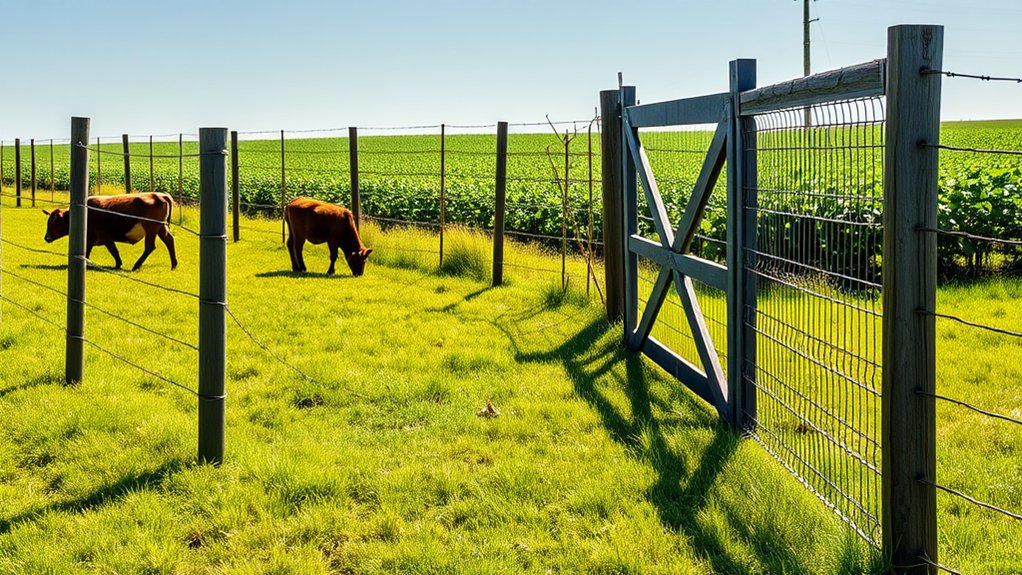
When selecting fencing for your farm, prioritize cost-effectiveness and durability to ensure a wise investment.
Consider versatility, as different fencing types can meet the varying needs of your livestock and land.
Additionally, look for options that are easy to install, saving you time and allowing you to concentrate on other vital farm tasks.
Cost-Effectiveness and Durability
When choosing fencing for your farm, consider both cost and durability for a smart investment. Here are four options to think about:
- Hi-Tensile Wire Fencing: Affordable to install and can last up to 50 years.
- Barbed Wire Fencing: Cost-effective for security, but it can injure livestock.
- Woven Wire Fencing: Ideal for smaller animals and budget-friendly for small farms.
- Electric Fencing: Low installation cost and easy maintenance, suitable for various livestock.
Each option has its pros, so take your time to choose the best one for your needs.
Versatility for Diverse Needs
Choosing the right fencing for your farm involves more than just cost and durability; it’s about finding options that fit various needs.
Different materials work well for different terrains. For example, high-tensile wire and electric fencing effectively contain livestock while ensuring safety. If you have mixed livestock, woven wire is a great choice, while post and rail fencing is better suited for larger animals.
Portable fencing offers flexibility for seasonal grazing adjustments. Additionally, using barriers to protect crops from wildlife can enhance land use and security.
With these diverse fencing options, you can tackle multiple agricultural challenges efficiently.
Ease of Installation
Installing farm fencing can be easy and efficient if you choose the right type. Here’s a quick breakdown of your options:
- High-Tensile Wire: Fast to set up, needs fewer posts, and is cost-effective and low-maintenance.
- Electric Fencing: Quick to install, great for temporary setups, and adapts easily to changes.
- Chain Link: Easy to assemble with pre-made parts, allowing for quick installation.
- Woven Wire: Requires more effort, but it’s sturdy and easy to repair.
Selecting the right fencing type can make your installation smoother, getting you ready for livestock and crops without delays.
Challenges in Farm Fencing
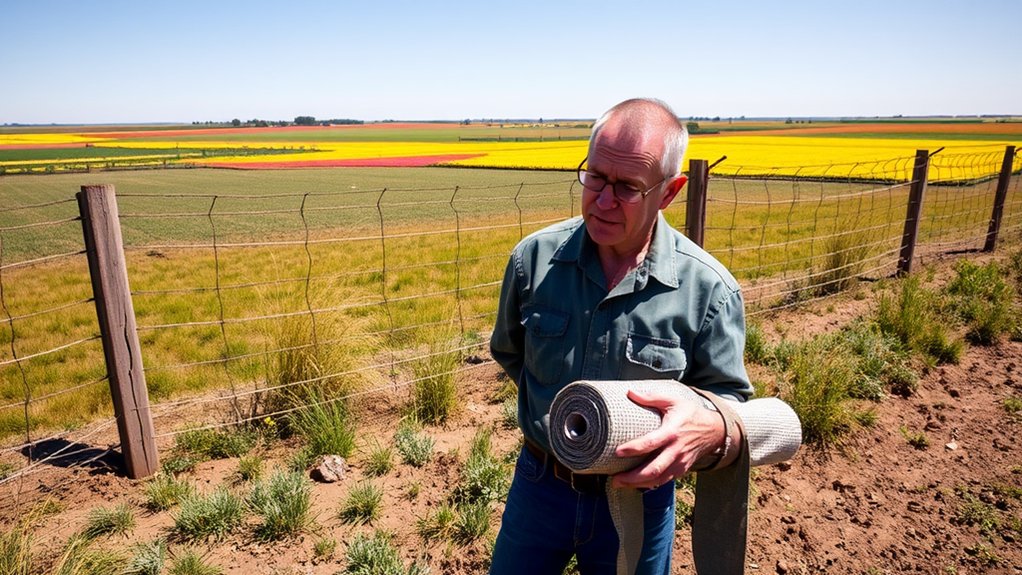
Farm fencing is crucial for keeping livestock safe and protecting them from predators.
To effectively secure your animals, consider fencing options that not only prevent escapes but also deter threats like coyotes or stray dogs.
For example, using sturdy fencing materials like woven wire or electric fencing can be effective.
Understanding these challenges helps you choose the right fencing solutions for your farm.
Predator Protection Strategies
When protecting your farm from predators, effective fencing is crucial for keeping your livestock safe.
Here are some key strategies to consider:
- Material Choice: Opt for durable options like high-tensile wire, woven mesh, or electric fencing.
- Height and Depth: Ensure your fence is at least 6 feet tall and buried 12 inches underground to stop climbers and diggers.
- Regular Maintenance: Check your fences regularly for any damage and fix issues quickly.
- Environmental Suitability: Use fencing materials that can handle your area’s weather conditions. Additionally, consider using composite fencing as it combines durability with low maintenance, making it a viable option for farms.
Safety for Livestock
Effective farm fencing is crucial for keeping your livestock safe. Different animals have different needs; for example, goats require tighter wire spacing to prevent escapes.
When choosing fence heights, consider your livestock’s behavior—too high can cause anxiety, while too low might lead to jumping. Innovations like smart fencing systems and flexible materials can reduce injury risks.
Regular maintenance is key to avoid damage and comply with local regulations. Additionally, ensure your fences are visible to prevent wildlife collisions, enhancing both safety and environmental balance.
Sustainability in Farm Fencing Choices
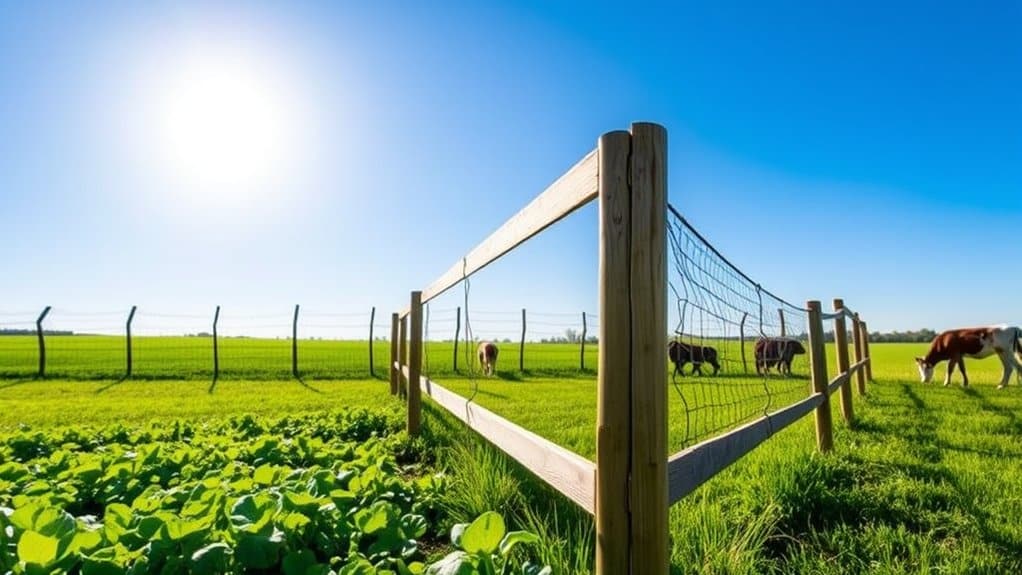
Sustainable farm fencing is crucial for modern agriculture due to its environmental impact. Choosing eco-friendly materials can lower your carbon footprint and support local ecosystems.
Here are four practical strategies:
- Recycled Materials: Use HDPE fencing, which isn’t only durable but can also be recycled again.
- Bamboo Fencing: Opt for bamboo, a fast-growing plant that’s both strong and flexible.
- Living Fences: Plant native shrubs to create natural barriers that enhance biodiversity.
- Energy-Efficient Solutions: Consider solar or wind-powered fencing to save on energy costs and meet environmental standards.
These sustainable choices contribute to soil health, improve water management, and support regenerative farming, benefiting both your land and operations.
Aligning Fencing With Agricultural Goals
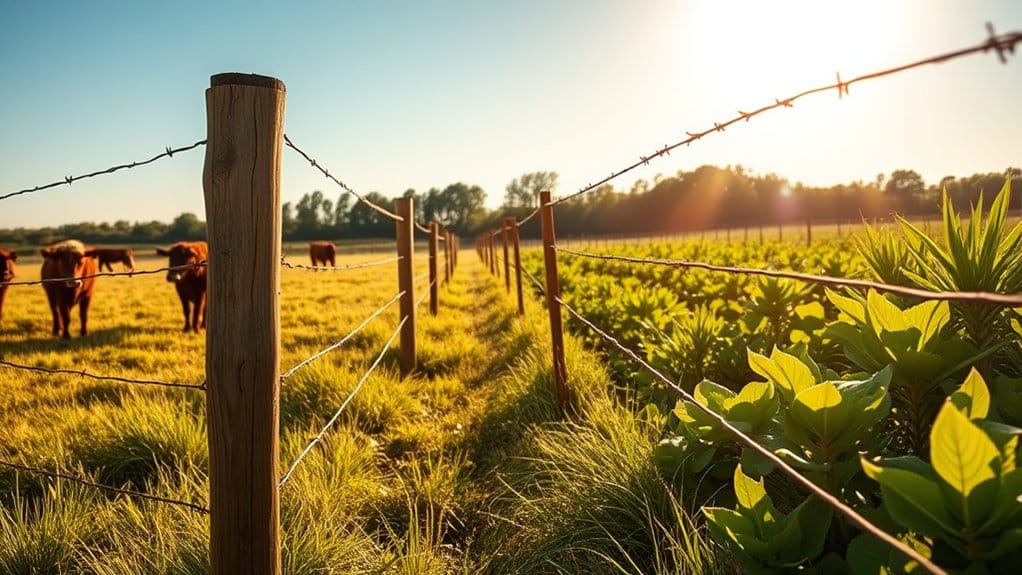
Aligning your fencing choices with agricultural goals improves livestock management and crop protection. Think about your needs—whether you need to keep large animals in or keep wildlife away from your crops.
| Fencing Type | Purpose |
|---|---|
| Post and Rail | Keeps large livestock contained |
| Electric Fencing | Deters wildlife while offering visibility |
| Deer Fencing | Protects crops from deer |
| Mesh Wire Fencing | Shields against smaller pests |
Choosing fencing that balances aesthetics and functionality can help meet zoning regulations, making your farm both efficient and visually appealing. The right fencing allows you to designate areas for grazing and crops, streamlining your agricultural operations.
Frequently Asked Questions
How Do I Determine the Right Height for My Fence?
To find the right height for your fence, think about the size and behavior of your livestock. For example, taller animals like horses may need a fence of at least 5-6 feet to prevent jumping. Also, check local regulations and consider environmental factors like wind or snow that could affect the fence’s stability. This will help ensure your livestock stays safe and secure.
What Are the Best Materials for Coastal Farming Areas?
In coastal farming, it’s crucial to have a strong fence that can withstand harsh conditions. Opt for salt-resistant materials like stainless steel and vinyl, or choose durable woods such as pressure-treated wood and northern white cedar. These options ensure your fence lasts longer and requires less maintenance.
Can I Install Fencing Myself, or Should I Hire Professionals?
You can save money and customize your fence by doing it yourself, but hiring professionals can ensure quality and expertise. Think about your skills and available time. For example, if you’re handy and have the time, DIY might be a good fit. But if you lack experience or want a perfect finish, hiring experts could be the better choice.
How Often Should I Replace Old Fencing?
Replace your fencing based on its lifespan and condition. Regular maintenance can prolong its life, but if it shows signs of significant wear or damage, it’s time to invest in a new one. Think of it like replacing worn-out shoes; if they’re falling apart, it’s better to get a new pair than risk injury.
What Are the Best Practices for Combining Different Fencing Types?
To ensure your fence works well, consider mixing materials like high-tensile wire with rail fencing. This combination boosts durability and meets different livestock needs, all while saving you money and reducing maintenance.
Conclusion
Choosing the right fence for your farm is crucial for protecting livestock and crops. Properly installed fencing can cut livestock losses by up to 70%. Consider your specific needs and explore different fencing options to boost productivity and ensure safety for your animals and plants. Remember to think about maintenance and sustainability, so your fencing aligns with your long-term farming goals.
